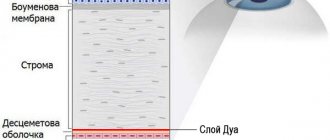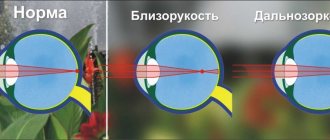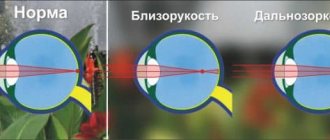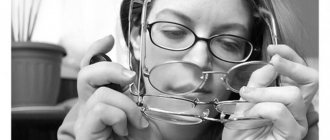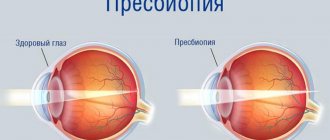What is myopia?
Myopia or, as experts scientifically call it, myopia is a violation of visual function, which manifests itself with a pathological increase in the anteroposterior axis of the eyeball or excessive refraction of light rays that are projected not on the retina, as under normal conditions, but in front of it. As a result, a person experiences blurry vision of distant objects, while near vision remains normal. Such a refractive error can be congenital and manifests itself in preschool children, but in ophthalmological practice acquired myopia is more common, which is explained by the increased load on the visual apparatus in the process of its formation. Research shows that during the period of study the development of myopia occurs in 20-25% of students. Most often, the pathology manifests itself in children from 9 to 12 years old; the risk of myopia in adolescents 15-16 years old is also high, since the disorder intensifies as the load increases.
If an examination of the visual system in a child reveals an increased size of the eyeball, myopia is called axial myopia. If a specialist detects a large refractive power in a patient, which contributes to the focal length between the retina and the collecting point of light rays, the anomaly is called refractive. Often children have a combination of both types of myopia. As a result of the factors described above, a person can hardly see objects located in the distance; they seem blurry and blurry. Often the visual acuity indicator becomes below one.
For example, when myopia manifests itself, children have difficulty seeing text written on the board, have difficulty playing with a ball, and their visual organs quickly get tired when reading, writing and working at the computer. In this regard, school performance decreases, and self-esteem may also suffer - the child is forced to limit his range of interests, becomes withdrawn and lacks self-confidence. That is why, if problems are detected, you should immediately contact a specialist and promptly correct myopia.
A separate issue is the presence of progressive myopia in children, in which it becomes necessary to periodically change vision-correcting agents to stronger ones.
It is important to understand that with the continued growth (elongation) of the eyeball, problems arise in the choroid and retina, their nutrition is disrupted, and dystrophy develops. This leads to a significant deterioration in visual ability, which is sometimes difficult to correct only with the help of simple glasses or contact lenses. Is it possible to cure myopia in a child that is progressing? There is no consensus in ophthalmology on this issue. Each method of treating and controlling myopia has certain advantages and disadvantages.
Method 1. “Step gymnastics”
Helps improve accommodation processes and quickly restore visual acuity. In order to teach your child the technique, it is better to first master the entire technique yourself.
- Stand 1 meter away from the window.
- Extend your straightened arm in front of you, palm facing you, and look at all the lines on it.
- Slowly move your gaze to the window frame and look at it carefully.
- Look out the window. Focus your gaze on an object located no further than 50 meters from it. If it is a bush or tree, look at the leaves, large and small branches.
- Find with your eyes an object located at a distance of approximately 100 meters from the window. If this is a building, take a closer look at its windows, consider the loggias.
- Then move your gaze to the clouds, somewhere high, to infinity.
- Gradually return your eyes to the skin pattern of the palm, moving your gaze in the direction of the building, wood, frame of the palm.
Repeat the exercise several times, each time focusing your gaze for 5-10 seconds on each of the objects in question. Training helps strengthen the accommodation apparatus, because it forces the eye to focus on the required distance given to it.
Visual gymnastics should be performed for 3 minutes on “each step” and for 3 minutes “every other step”. You should always complete the exercises smoothly, paying attention to each step.
If there is significant stress on the visual system (reading books, working on a computer, embroidering, etc.), it is better to perform the technique hourly.
The exercises are recommended from the age of five. The younger the child, the more explanations he needs from an adult on their technical implementation. At an older age, it is enough to simply motivate a child that gymnastics will improve his vision and help him get rid of glasses. For a teenager to master the technique, it is usually enough to explain all the exercises to him 1-2 times.
Types and degrees of myopia in children
Depending on the nature of the occurrence of myopia in a child, as well as at what stage of development the eye disease was identified and its correction was prescribed, ophthalmologists distinguish degrees of severity:
- weak - up to -3 diopters;
- medium - from -3 to -6 diopters;
- high - from -6 diopters.
With a weak degree of myopia, it does not cause headaches or dizziness in the child. He sees objects blurry at a distance of 6 to 10 meters. The onset of the disease often occurs between the ages of 6 and 8 years. The average degree of myopia already causes serious discomfort, children have difficulty distinguishing objects that are further than an arm's length away, and rapid fatigue of the visual organs occurs. As a rule, this degree of myopia is observed in children 11-12 years old during the period when the load on the visual system begins to increase.
A severe form of the pathology does not allow the child to distinguish the outlines of objects at a distance of more than 10 centimeters from the face. He has poor spatial orientation. Myopia can reach a high degree of severity with regular high visual loads by the age of 14.
Experts also distinguish myopia by the speed of development. It happens:
- Stationary - the anomaly is fixed at a certain optical indicator, which does not decrease in the future;
- Progressive - visual ability deteriorates with a certain frequency, sometimes by several diopters per year.
Both forms of myopia can occur in a child at any age: 8, 12, 14 years, etc. If we talk about the causes of pathology in children, it is necessary to understand that it can be inherited, congenital, or acquired.
How to restore a child's vision?
The eyes have a very complex structure. Depending on environmental factors, vision may improve or deteriorate. In order to restore vision at home, you first need to understand the reasons for its deterioration and contact an ophthalmologist for advice.
There are several general concepts that will help both prevent further deterioration of vision and improve it.
Firstly, it is necessary to regularly do special exercises for the eyes to enrich them with blood and so that they rest after prolonged stress.
Secondly, give your eyes proper rest, including proper sleep.
Thirdly, do not let your eyes become overstrained; you should not sit at a computer, TV, or tablet for a long time.
Fourth, adjust your diet so that your eyes receive all the necessary beneficial elements.
Fifthly, follow the recommendations of the ophthalmologist to improve vision specifically for your child and, if necessary, use additional means prescribed by the doctor.
Hereditary myopia in children
Ophthalmologists say that an anomaly such as myopia is not transmitted at the genetic level.
However, a child can inherit a predisposition to it. So, if both parents are diagnosed with myopia, then the likelihood of it occurring in children increases significantly. That is why it is necessary to regularly examine children predisposed to this eye disease from a very early age (do not wait, for example, 8-9 years) in order to begin treatment on time if necessary. According to the results of the study, if both parents suffer from myopia, in 50% of cases the child develops this disease before the age of 12-18 years. At the same time, only 8% of children have myopia if their parents’ vision is normal.
Farsightedness in children. Prevention
Any doctor will tell you that prevention is better than any treatment. And under no circumstances should you ignore it. Some eye clinics are seriously concerned about preventive measures and have developed a number of their own techniques, which include hardware procedures. What will they be like? Only a doctor can answer this question, taking into account the child’s age and the degree of pathology. Currently, specialists resort to both massage (vacuum) and electrical stimulation - either type improves the metabolic processes of the eye structures, helps eliminate discomfort and accommodative spasm. These procedures usually do not cause fear in a child, since they take place in a playful way. How long the preventative treatment will last again depends on the individual characteristics of the patient. On average, courses are held five times a year.
How does congenital myopia manifest in a child?
Babies are often born with various pathologies of the lens and cornea of the eyes, for example, with a weak sclera or weakened ciliary muscle. The child may also have glaucoma. All these factors are provoking factors for the occurrence of myopia. If the eye muscles that are responsible for changing the curvature of the lens are poorly developed, the baby sees poorly, and myopia progresses. Prematurity is also a significant cause of myopia. It is observed in about a third of children who were born ahead of schedule.
High load on the visual system
Due to the anatomical feature of the eyes, when the gaze is focused on nearby objects, the child reflexively strains some parts of the visual apparatus. The longer and more often this process occurs, the more the eyeball is subject to changes in the form of growth.
That is why, with poor-quality lighting, incorrect distance of a book, notepad, gadget, monitor or small objects from the face, or prolonged time spent watching TV, additional strain on vision occurs. These factors provoke the occurrence of myopia. For example, an 8-year-old child’s eyes are subject to excessive fatigue because he studies at school for a long time during the day, then works on homework using a smartphone and computer, and can get carried away by watching TV.
Incorrect correction of a child’s myopia and its absence
At the first symptoms of myopia and the absence or incorrect choice of appropriate measures (incorrectly selected glasses or contact optics), myopia can become progressive, which will lead to disastrous consequences. You also need to know that visual pathology can be caused by rickets, spinal injuries received by a child during childbirth, and infectious diseases such as diphtheria, hepatitis, measles or scarlet fever. In addition, the occurrence of myopia is influenced by other concomitant diseases, for example, inflammation of the adenoids, diabetes mellitus, and disorders of the musculoskeletal system.
Myopia symptoms
You should contact an ophthalmologist if you notice the following symptoms in your child:
- rapid fatigue of the visual organs;
- frequent headaches and dizziness;
- squinting when trying to look at distant objects;
- rubbing the eyes with hands, inability to read text on the blackboard, constant switching of attention (may occur in a child 8 years old and older);
- When writing and reading, bring the text as close to the eyes as possible.
In order to understand in time how to treat myopia in children, it is important to regularly undergo scheduled examinations in a specialist’s office. At the same time, parents may notice changes in their children’s behavior before the upcoming examination and not wait for the deadline set for admission.
How to recognize myopia
Myopia can be diagnosed in a one-year-old child by observation: if the baby pulls all objects closer to him and blinks frequently, this may be a signal that it is time to see a doctor, especially if one of the parents suffers from this disease.
Up to 3 years of age, a child is examined only by observation. From the age of three, vision is checked using special tables. If a decrease in visual acuity is detected, the doctor recommends corrective lenses that will help improve vision.
Children aged 5 years and older need to have their eyes checked every year, as they are all at risk for developing myopia. School-age children may develop mild or moderate myopia. The disease, as a rule, does not progress and does not cause complications.
The main sign that a child aged 5-10 years is developing the disease is a deterioration in the visibility of objects and objects located at a distance. Schoolchildren may complain that they cannot clearly see the material written on the board, but when they move closer, the situation is resolved.
Children with established myopia should be seen by a doctor at least once every six months.
The progression of the disease can begin at age 6 and end by adulthood. As myopia progresses, complications may develop and vision may not be restored.
Does your child need glasses?
With myopia in children, many parents ask this question, especially if the child’s vision problem is minor.
Of course, the best option is to consult an ophthalmologist. However, wearing glasses in the early stages of childhood myopia development has a positive effect on the course of the disease.
Wearing glasses in childhood from 1 to 10 years old can stop myopia in children and restore vision.
Another question is that the child will not want to wear glasses. But now the choice is great, and you can choose beautiful glasses that your little patient will like.
Diagnosis of myopia in children
At the initial stages of the examination, a simple survey of not only the child, but also the parents helps specialists find out the necessary information. The doctor finds out the subject of the complaints and the timing of their appearance, clarifies how the pregnancy and childbirth proceeded, what diseases bothered you earlier, whether the pathology is a hereditary factor, what changes in vision occurred over time. After an extensive conversation, the ophthalmologist begins diagnosing the child’s vision, which includes the following algorithms:
- External examination of the visual organs, which allows you to determine the position and shape of the eyeballs.
- Examination using an ophthalmoscope, this gives an idea of the size and shape of the cornea, helps to assess the condition of the anterior chamber, vitreous body, fundus and lens.
- Skiascopy involves diagnostics using a skiascope ruler and an ophthalmoscope and allows you to identify the type and degree of refractive pathology.
- Ultrasound is necessary to determine the length of the anteroposterior axis of the eyes and identify complications and their causes.
Mandatory routine examinations with a doctor must be carried out for infants at 3, 6, 12 months, and then at 3 years. At school age, when the load on the visual system increases, children should be examined at least 2 times a year.
Treatment methods. How to restore vision in children?
After the examination, treatment should be started immediately if farsightedness is detected. So, if your child is of preschool age, then he needs vision correction with lenses with a “plus” sign, even if the degree of hypermetropia is first or second. At the moment when the child begins to go to school (6-8 years), the load on the eyes becomes much stronger, which means the treatment is adjusted to take it into account. At this age, the ophthalmologist usually prescribes glasses for close distance (weak or second stage of farsightedness). If the third degree is diagnosed, then correction with glasses or contact lenses is resorted to on a regular basis. It happens that at school age a child does not want to wear glasses, as classmates may start teasing him. In addition, this is unnecessary inconvenience and the fear of breaking or losing the optics. Then you should consult with an ophthalmologist and choose the most comfortable contact lenses to wear. Today, the world's leading brands approach the development of lenses extremely scrupulously: they use only the latest materials, increase oxygen permeability, and paint products in a barely noticeable color for comfort.
There is another way to correct farsightedness and myopia - laser correction. But doctors do not advise performing the operation before adulthood, since the child’s visual system is formed up to this age. However, if the situation is critical, surgical intervention becomes indicated, but only after a prolonged examination.
How is myopia treated in children?
In order to understand how to cure myopia in a child, it is necessary to determine whether the disease is progressing, whether there are complications and what its severity is. Ophthalmologists warn: it is impossible to completely eliminate visual pathology in children, since the visual apparatus, as is known, continues to develop until the age of 18. However, it is possible to stop or slow down the development of myopia. This occurs with the help of corrective optical aids (glasses or contact lenses), as well as preventing the development of complications in the visual system.
As mentioned earlier, special attention should be paid to the progressive form of myopia. A decrease in the optical power of the eyes by no more than -0.5 diopters per year is considered acceptable. In this case, the possibility of maintaining visual ability will depend on the timeliness of treatment. What to do if a child’s vision is rapidly deteriorating? Specialists try to treat myopia in children comprehensively, regardless of its severity, which allows them to achieve the best results.
The bespectacled man by mistake
Sometimes, when a child is diagnosed with myopia, I “arm” him with glasses, when he does not need them at all, since the diagnosis is false! Vision deteriorates due to poor functioning of the intraocular muscle, and glasses only reinforce this situation. It is also dangerous that “false myopia” can develop into true myopia and progress, leading to a rapid decrease in vision. To prevent this from happening, therapeutic treatment is necessary, which improves metabolism and blood supply to the eye, and also regulates the functioning of the visual centers of the brain. What if the child has “true myopia”? The doctor will decide whether to wear glasses or try hardware treatment. In this case, you will have to monitor whether the disease is progressing, and measure the length of the cornea of the eye every six months (as it increases, the degree of myopia increases).
How is myopia corrected with glasses and contact lenses?
The selection of glasses or contact lenses occurs when the child becomes relatively independent. If he is found to have mild or moderate myopia, the specialist will write a prescription for corrective agents for distance vision only.
Multifocal contact lenses with several optical zones for vision not only at distance, but also near.
Ophthalmologists know that vision-correcting products, when worn constantly, have an ametropizing effect. Therefore, it is undesirable to prescribe them to children continuously, as follows:
- In a child, as in an adult patient, the tension of compensatory mechanisms is reduced and adaptation to optical distortion is leveled.
- The possibility of emmetropization is blocked. In other words, the body’s ability to return to a genetically predetermined growth curve is reduced, even when the development trajectory has been disrupted for some reason.
Surgical intervention for myopia in children
If a child is diagnosed with high myopia or its progressive form is identified, surgical intervention may be necessary. However, it is strictly not recommended to undergo laser vision correction before the age of 18, so the operation will be aimed at strengthening the scleral membrane of the visual organs. This method in ophthalmic surgery is called scleroplasty. All surgical procedures are divided into two groups. Scleroplasty belongs to the first, and many other methods for eliminating refractive error belong to the second.
Anterior radial keratotomy
The radial keratotomy method involves making incisions in the peripheral zone of the cornea. It is used for severe myopia. The longer the anteroposterior axis of the eyeball, the more notches will need to be made and the deeper they will be. As a result of scar formation, the optical zone of the cornea becomes flattened and its refraction decreases. However, the procedure can have negative consequences that lead to complications, so today it is rarely used in ophthalmological practice.
Myopic keratomileusis
School-age children with a high degree of myopia may also be prescribed myopic keratomileusis. During the operation, the doctor, using a special instrument, cuts off the upper layers of the cornea, after which he crushes and removes part of the stroma, and finally places the upper layer of the cornea in its original place and seals it with a continuous suture. The thickness of the stroma layer removed will depend on the severity of myopia. The main indicators of the effectiveness of treatment of visual pathology are the normalization of the intersection of light rays in the central zone of the retina and the improvement of the patient’s quality of vision. In childhood, the goals of myopia correction include:
- prevention of complications;
- slowing down or completely stopping the progression of the disease;
- correction of visual ability.
Prevention of myopia in children
From a very early age, parents should teach their child to follow a number of simple rules while reading, which will help avoid vision loss:
- the distance from the face to the book should be at least 30 cm;
- it is important to regularly monitor your posture during the educational process;
- read only in proper lighting;
- Do not do the lesson in a lying position.
In addition, it is very important to ensure that the table matches the child’s height. It is also necessary to pay attention to the chair on which the student will sit - his legs should be bent at an angle of 90° and reach the floor. The light that falls on the work area must be placed on the left for right-handed people and on the right for left-handed people.
If a child is going to first grade, it is advisable to consult with an ophthalmologist and find out which desk he should sit at and whether vision correction is necessary. It is also important to limit (within reasonable limits) the time you spend working on a computer, using a smartphone, and watching TV. It is especially important that the child does not do this in complete darkness.
It is equally important to provide your child with a balanced diet and the use of vitamin complexes.
Products good for vision
First of all, if you want your child’s vision not to deteriorate, you need to pay attention to nutritious, regular, proper nutrition. Only when the child receives all the necessary vitamins and minerals can vision be further improved. If you realize that your child’s vision is deteriorating, you need to add additional products to the daily menu that contain lysine and beta carotene. Typically, such products have a distinctive orange color. They are the ones who will give the retina all the benefits.
Such products can be blueberries, dried apricots, persimmons, oranges, carrots, red fish, pumpkin, beef liver, sea buckthorn and much more. The main thing is that meals are regular. And you should not give products only from this list, because too much of these beneficial substances can also cause side effects.
Vitamins are necessary for a full life and nutrition of the eyes. There are four essential vitamins without which the eye cannot function fully. But to understand exactly what vitamin is missing, you need to know how it manifests itself. Vitamin A deficiency affects visual acuity in low light. If there is not enough vitamin A, then the perception of color and outlines of objects in low light deteriorates.
A lack of vitamin E manifests itself in the same way as a lack of vitamin A, because it is responsible for the absorption of vitamin A, and also slows down the development of other eye diseases.
A lack of vitamin C contributes to decreased visual acuity, sleep disturbances, lethargy, and rapid fatigue.
A lack of vitamin B2 causes rapid eye fatigue during exercise. Acute reaction to light, inflammation.
Balanced diet
As already mentioned, vitamins, minerals and other beneficial microelements help maintain healthy vision and maintain its sharpness. This is why it is very important to enrich your child’s daily diet with foods that contain a variety of healthy foods. These include citrus fruits, black currants, apples, spinach, pork liver, cranberries, eggs, and fish oil. They contain vitamins A, B, C, lutein, anthocyanins, which increase immunity.
So, a balanced diet to maintain healthy vision may consist of:
- vegetables - sweet red or yellow peppers, beets, pumpkin, peas, fresh and sauerkraut;
- greens - dill, parsley, spinach, lettuce;
- bread - gray, black and with bran;
- soups - fish, vegetarian, dairy, cooked from lean meat;
- meat and fish - seafood, beef, poultry, rabbit, lamb;
- cereals - buckwheat, oatmeal, dark pasta;
- eggs;
- dried fruits - dried apricots, raisins, prunes, figs;
- fresh fruits and berries - blueberries, rowan berries, melons, apricots, oranges, tangerines, grapefruits;
- fermented milk products - cheese, cream, cottage cheese, kefir, yogurt without additives;
- vegetable fats - olive, mustard, linseed oil;
It is advisable to eat food in fractional parts 4-6 times a day.
Unbalanced diet
Few parents know that nutrition has a significant impact on the quality of a child’s vision. It is important to understand that a deficiency of microelements such as calcium, magnesium, zinc, as well as various vitamins, provokes a decrease in visual acuity; all these components are necessary for the proper development of the tissues of the scleral membrane of the eyes.
As already mentioned, vitamins, minerals and other beneficial microelements help maintain healthy vision and maintain its sharpness. This is why it is very important to enrich your child’s daily diet with foods that contain a variety of healthy foods. These include citrus fruits, black currants, apples, spinach, pork liver, cranberries, eggs, and fish oil. They contain vitamins A, B, C, lutein, anthocyanins, which increase immunity.
So, a balanced diet to maintain healthy vision may consist of:
- vegetables - sweet red or yellow peppers, beets, pumpkin, peas, fresh and sauerkraut;
- greens - dill, parsley, spinach, lettuce;
- bread - gray, black and with bran;
- soups - fish, vegetarian, dairy, cooked from lean meat;
- meat and fish - seafood, beef, poultry, rabbit, lamb;
- cereals - buckwheat, oatmeal, dark pasta;
- eggs;
- dried fruits - dried apricots, raisins, prunes, figs;
- fresh fruits and berries - blueberries, rowan berries, melons, apricots, oranges, tangerines, grapefruits;
- fermented milk products - cheese, cream, cottage cheese, kefir, yogurt without additives;
- vegetable fats - olive, mustard, linseed oil;
It is advisable to eat food in fractional parts 4-6 times a day.




